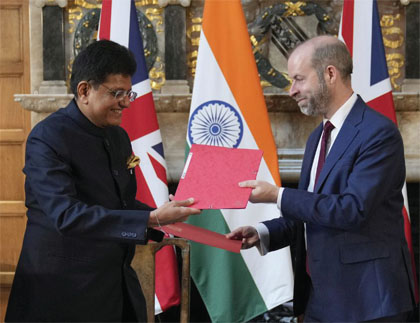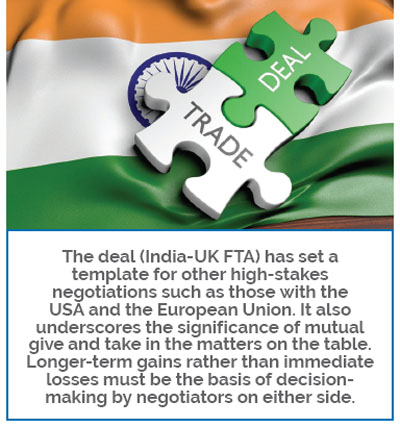The India-UK FTA is finally through, in the presence both prime ministers, scoring the high importance both governments have given this agreement. It is a testimony of Indian maturity and coming of age as an economy, in her ability to give and take, making it a win-win conclusion.
 Negotiations for a trade deal between India and the UK had initially commenced way back in 2007. Britain’s joining the European Union had derailed the process of bilateral negotiations, and it came to be resumed in 2022 upon its voluntary exit. The real urgency and the requisite flexibility in concluding a deal, however, were demonstrated only since early 2025 by Sir Keir Starmer’s Labour Government. By the first week of May, the two negotiating teams had agreed on the broad contours of a deal. Within ten weeks thereafter, a fully fleshed and legally vetted pact was readied and duly signed and sealed on 24th July in the presence of the Premiers of the two nations, which have almost the same sized economies and a long-shared history.
Negotiations for a trade deal between India and the UK had initially commenced way back in 2007. Britain’s joining the European Union had derailed the process of bilateral negotiations, and it came to be resumed in 2022 upon its voluntary exit. The real urgency and the requisite flexibility in concluding a deal, however, were demonstrated only since early 2025 by Sir Keir Starmer’s Labour Government. By the first week of May, the two negotiating teams had agreed on the broad contours of a deal. Within ten weeks thereafter, a fully fleshed and legally vetted pact was readied and duly signed and sealed on 24th July in the presence of the Premiers of the two nations, which have almost the same sized economies and a long-shared history.
The agreement covers not only trade in merchandise but also services, including movement of natural persons, and the issues of labour standards and their social security, IPR, investment flows, and public procurement. Rightly, it has been called a Comprehensive Economic & Trade Agreement (CETA). Along with it, the two heads of democratically elected governments also agreed on a Vision 2035 document listing out their envisaged ties and cooperation in climate change, critical minerals, maritime security, technology, and energy. The agreed step-by-step roadmap seeks to provide both countries a rules-based alternative to their supply chain dependence on China, Vietnam, and South Korea.
The Deal
Both nations seem to have consciously decided to vastly improve market access for one another’s products and effect substantial improvements in their bilateral trade, which is currently fairly modest – 2.4 percent of British trade and 1.8 percent of India’s combined merchandise and services trade. India’s average tariffs on British products were agreed to be lowered from the current 15 percent to 3 percent, while the UK allowed about 99 percent of India’s product lines, totaling 98 percent by value, to come in at zero duties. To allow industry in both nations the time to adjust to the lower import tariffs, the changes would be spread out, with a few reductions coming in immediately after the pact comes into force upon British Parliament’s ratification, and the rest in defined intervals within a time limit of 10 years.
 The British exports eligible for lower tariffs are eye-catching: scotch whisky and gin, with duties reduced from 150 percent to 40 percent over ten years and to 75 percent immediately. Luxury automobiles, currently attracting up to 110 percent, would pay 10 percent over 15 years depending on engine capacity, but be subject to an annual quota of 25,000 units. Duties on medical and meditech devices will come down from 13.75 percent to zero, while aircraft, their engines, and parts will experience staged cuts to zero from 7.5 percent. The duty on silver, the biggest item of British export to India, would be completely removed over 10 years, as would be the duties on British salmon, chocolates, and cheese. The Indian exports which stand to benefit significantly from zero duties are the entire range of labour-intensive products: textiles, footwear, gems and jewelry, generic pharmaceuticals, engineering products, marine produce, and food and agri products. Together these constitute 65 percent of Indian merchandise exports to the UK.
The British exports eligible for lower tariffs are eye-catching: scotch whisky and gin, with duties reduced from 150 percent to 40 percent over ten years and to 75 percent immediately. Luxury automobiles, currently attracting up to 110 percent, would pay 10 percent over 15 years depending on engine capacity, but be subject to an annual quota of 25,000 units. Duties on medical and meditech devices will come down from 13.75 percent to zero, while aircraft, their engines, and parts will experience staged cuts to zero from 7.5 percent. The duty on silver, the biggest item of British export to India, would be completely removed over 10 years, as would be the duties on British salmon, chocolates, and cheese. The Indian exports which stand to benefit significantly from zero duties are the entire range of labour-intensive products: textiles, footwear, gems and jewelry, generic pharmaceuticals, engineering products, marine produce, and food and agri products. Together these constitute 65 percent of Indian merchandise exports to the UK.
Besides bilateral trade, both countries have agreed to open up government procurement. Hitherto, India had restricted foreign competition in this area. Now, after safeguarding procurement for purposes of national security, protecting micro and small enterprises, and procurement of agri-products, it has permitted British vendors to be deemed Class II local suppliers, meaning they need only 20 percent local content and can compete in all tenders above a threshold limit on the same terms as Indian firms. Indian vendors, for sales to public bodies in the UK, will have a similar threshold of Rs 60 crores. The 10 billion dollar British National Health Service (NHS) procurement also stands opened to the Indian pharmaceutical industry.
For the first time ever, India has consented to link trade with labour issues. Hitherto, it was feared that already industrialised nations would exploit labour standards as a tool for trade protectionism. While recognizing its traditional apprehensions on this issue, the British government has acknowledged that India has the right to develop its own labour laws according to its own priorities. To promote cooperation in services, a more liberalised regime for movement of natural persons is envisaged.
A new visa route permitting up to 1,800 Indian professionals a year to work in the UK’s cultural and wellness sectors, including chefs and yoga instructors, has been agreed to. The two sides also agreed to recognize standards for nurses, architects, and other professionals. India agreed to open up its accounting and audit businesses to British firms while maintaining checks on legal services. To incentivize Indian firms, a UK–India Double Contributions Convention was agreed to. Indian IT firms temporarily employing Indian workers would be exempted from paying UK social security contributions for three years.
Another example of mature conduct by both sides is their agreement on a dispute resolution mechanism arising out of the CETA. Included in it is a provision that the complaining body may select a forum in which it wants to settle a dispute. It also states that a panel constituted under the new deal to settle a dispute shall consider relevant interpretations contained in the reports of a WTO panel or its Appellate Body. This demonstration of commitment by the UK and India to WTO jurisprudence—which the US has sought to discredit—is much needed to reinvigorate the world body set up to promote rules-based trade.
The Pact – A Benchmark for Other FTAs
While the outcome of the Indo–UK CETA will depend on how the implementation of the agreement takes place over the next 10 years and beyond, the way it came to be negotiated, especially in the last few months, has set a template for other high-stakes negotiations such as those with the USA and the European Union. It also underscores the significance of mutual give and take in the matters on the table. Longer-term gains rather than immediate losses must be the basis of decision-making by negotiators on either side.
For India, services are as important as merchandise, and the two would need to be taken up together for consideration. Being a labour-surplus economy, India remains as invested in exporting manpower as it is in exporting merchandise. Including such an issue also gives India greater elbow room to negotiate and make trade-offs between different sectors. Simultaneously, India can hold firm on key red flag, especially in agriculture and dairying, while remaining flexible on other fronts. Labour standards, gender discrimination, environmental protection, and phytosanitary measures, often seen as barriers to trade, should no longer be treated as sacrosanct or non-negotiable. Such a shift should facilitate India’s ongoing as well as future trade and economic negotiations.
ABOUT THE AUTHOR
 Dr. Ajay Dua is a former Union Secretary, Commerce & Industry and a development economist by training.
Dr. Ajay Dua is a former Union Secretary, Commerce & Industry and a development economist by training.








